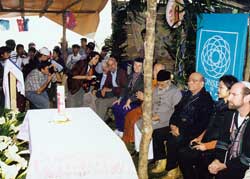Current Annual Report > Making Peace
Making Peace
Peace is in the details...
The Peace Councilors’ view of peace is comprehensive and holistic. Making peace is not simply stopping war. Peace is a way—and an environment that nurtures growth without fear. Peace grows from the smallest details of life.
Simple actions often are the most effective; even as simple as ?being there? with people who feel afraid and isolated in the midst of conflict and suffering.
The Peace Councilors meet annually to review progress and set programs for the next year. Meeting together also gives them a place and time to deepen friendships and inspire each other.
 Since 1995, when the Peace Council began, several guiding principles have emerged...
Since 1995, when the Peace Council began, several guiding principles have emerged...
• The Peace Council gets involved only at the invitation of a trusted local peacemaker. In all cases so far this is a member of the Peace Council. This means that the Council goes into an area with local support and with an infrastructure of local people and organizations that can help do the work, and it means that there is an experienced local peacemaker (a Peace Councilor) who knows what will be most helpful and who knows how to navigate what are often confusing and even treacherous cross-currents in the conflict.
• The Peace Councilors prefer to meet in a place where the meeting itself can contribute to an ongoing peace process.
• Peace Councilors listen first. They do not enter an area with a preconceived notion of what should happen there or what might be most helpful. In this process, people who are suffering reveal their aspirations—more than their problems—and the Peace Council can respond.
• The Peace Council has a bias for practical actions that promote peace, positive examples of interfaith cooperation, rather than declarations or statements (although these also can be useful). A long-term commitment is usually needed. Peace is not made in a single visit.
• Every program is different, because each situation is unique. So peace comes in many forms. It may be written protests or interventions in human rights abuses, over the signatures of the Peace Councilors; or communal bread-making or weaving cooperatives in refugee villages in Chiapas; or a shelter for victims of prostitution and rape near Bangkok; or a program to build trust and dialogue in North Korea and medicines sent to hospitals there; or interfaith representation at meetings of diplomats and NGOs negotiating a treaty to ban land mines.
Home ||
About the Peace Council ||
Peace Councilors ||
Purpose and Commitments ||
Current Annual Report ||
Looking Ahead ||
News ||
Trustees ||
How You Can Help ||
Links ||
Contact ||
Page Published: 07/17/2002 · Page Last Modified: Thursday, December 6, 2007
©2003 International Committee for the Peace Council
